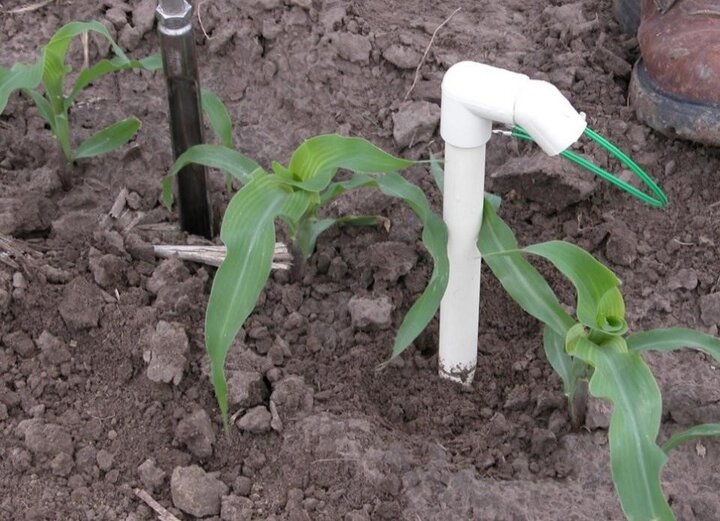Is It Too Easy To Turn The Irrigation Water On?
I have worked with irrigation management for almost 20 years. Today most farmers are doing a better job than when I started, however many still tend to over apply water -- leaving room for improvement. That left me wondering “Why” and “What could help more farmers apply the optimal amount of irrigation water?”
Each year, the Upper Big Blue NRD requires each farmer to use soil water monitoring equipment in one irrigated field, and to turn the data in to the NRD. After reviewing the data over the past few years, I found about 1/3 are doing a good job of applying the correct amount of water that will minimize deep percolation while producing top yields. The other 2/3’s could save some money and water without lowering yield. In fact, about 25% could save a lot!
Most farmers I work with try very hard to keep the cost of production as low as possible without compromising yield. So why do some spend extra money pumping more water than needed? Well, they apparently do not think they are pumping more water than needed. Every farmer has hundreds of decisions to make each day and when to start the next irrigation can become just another decision that needs to be made quickly before moving on. But think about this: if your fuel delivery guy pumped 500 gallons of diesel in your tank to fill it, and then pumped an extra 100 gallons that overflowed the tank, just to make sure it was full, how happy would you be with him? At a very real level, that is what many irrigators are doing when pumping water into the soil profile.
I wonder, is it just too easy to turn the irrigation water on? Many systems today can be started by just touching a button on the smart phone. If you had to go to the bank and take out eight or ten $100 dollar bills to feed into each pivot before it would start, would you want more information about the available water reserves in the soil? We all know the reason fast food restaurants started taking credit cards, right? Because it is well known that people will stop more often and spend more money if they can use plastic. Therefore, I suggest you consider for yourself: if you had to spend cold, hard cash to start the pivot vs. paying the cost when the bill comes later on, would you do anything different?
Consider spending more time and money to get good data and analyze it to make great irrigation scheduling decisions. Pumping water is the largest energy bill on most irrigated farms in Nebraska. In addition, over irrigating can carry some of your valuable inputs below the root zone. This is a leading cause of increasing nitrate level in the groundwater and can lower crop yields. For more information on yield losses take time to read the following NebGuide: Plant Growth and Yield as Affected by Wet Soil Conditions Due to Flooding or Over-Irrigation
My Vision
Every irrigator can make excellent irrigation scheduling decisions by getting the right information and polishing their skills in analyzing the data. Today it is easier than ever to install equipment that will automatically record and help analyze the data before sending it to your computer or smartphone. Your diligence will be rewarded with higher profitability and protecting the environment.
First Steps
Many of you already use soil water monitoring equipment or ET data to make good decisions. The only thing you need to do is continue what is working and hone your analysis skills.
Now is the time to get the probes in the ground. While other tasks may seem more pressing, early installation of sensors is important to ensure proper operation during the later critical growth phases. Early installation helps to minimize root and leaf damage and makes it easy to get around the field with the pickup or ATV to install the equipment. Keep in mind that the plants next to the probes are an integral part of the sensor and must be protected so they can represent all of the other plants in the field. Do not install the sensors when the soil is wet and make as few footprints as you can to prevent soil compaction.
Support for People Wanting to Improve Their Irrigation Management
For those that have not collected data in the past or would like to hone your scheduling skills, take some time now to figure out what will work best for you. Many resources are available to help. A great five-part video series was recently recorded that can be found on the CropWatch YouTube channel at: How to Schedule Irrigations with Soil Water Data. Other articles include: Irrigation Sensor Installation Tips, Value of Using Sensors to Manage Irrigation and Tips for Proper Installation, Irrigation Scheduling: Checkbook Method, Soil Water Sensors for Irrigation Management, How Much Irrigation is Needed on Corn in the Vegetative Growth Stage? Nebraska Extension has educators and specialist across the state that would be happy to help you develop a plan as well. Feel free to send me an email if you would like so we can set up a time to talk. My address is steve.melvin@unl.edu. In addition, many NRD’s across the state offer cost share on irrigation equipment.

Figure 1. Early installation helps to minimize root and leaf damage and makes it easy to get around the field with the pickup or ATV to install the equipment.
This article was reviewed by Aaron Nygren & Troy Ingram